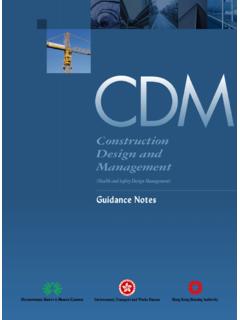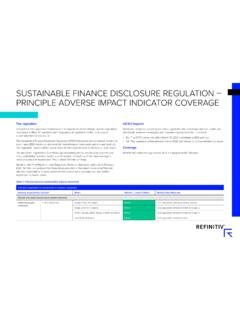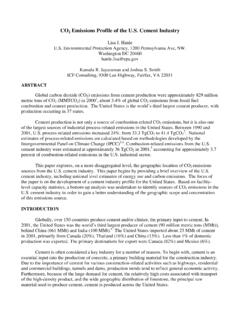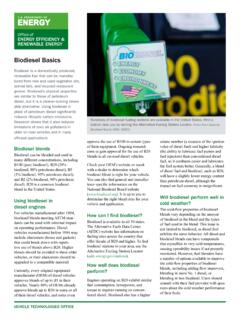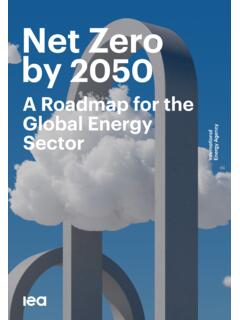Transcription of Carbon Dioxide (CO2) Emissions of Concrete
1 TCarbon Dioxide (CO2) Emissions of Concrete Presented by: Ir. Stephen Leung A M i l T h lArup Materials Technology SCCT 200927 February 2009 tGl b l Wi Ei iCb Ei iCPresentation Content Global Warming Hong Kong Climate Changes and CO2 Emissions Carbon Footprint (t CO2) and Reducing Carbon Emission Embodied CO2 (eCO2) of Reinforced Concrete Possible Alternatives Challenges SummarySummary t thiGlobal Warming Global Warming is caused by sharply increased greenhouse gases emission byhuman activitieshuman activities In the building industry, Carbon Dioxide (CO2)emission mainly comes from cementemission mainly comes from cement production It accounts for 2% -3% of human generated It accounts for 2% 3 % of human generated CO2 production and consumes about of total energy consumption.
2 Concrete , as a material, can never be truly sustainable, but we can reduce its impact on the environment yHong Kong Climate The Hong Kong Observatory No. of cold days are declining No. of hot nights are increasing Urban areas are warmer than the countries side by 6 C in some of the late evenings tt Hong Kong Climate Tall buildings in Hong Kong are heated di h d d l h lup during the day and release thermal energy over night Tall buildings also surround the inner city and inhibit the cooling effect of airy g circulation RESULTING HOT WEATHER!
3 !RESULTING HOT WEATHER!! Hong Kong CO2 Emissions In Hong Kong, greenhouse gas Emissions are approximately 6 tons CO2 equivalent per capita *Figure source from EPD Hong Kong CO2 Emissions (2) CO2 emission per capita in Hong Kong is relatively low CO2 emission per capita in Hong Kong is relatively low when compare to other international developed countries *Figure source from EPD Hong Kong CO2 Emissions (3) The largest growth in CO2 Emissions has come from power The largest growth in CO2 Emissions has come from power generation and road transportation *Figure source from EPD t sto tentg Carbon FootPrint (t CO2) Carbon footprint is used to calculate th f d d d b the amount of damaged caused by an individual, household, institution or b iness he ironment hro hbusiness to the environment through harmful Carbon Dioxide Emissions .
4 Ti blit i i ithti itiEW lkiC li Carbon FootPrint (t CO2) Reducing tCO2 EmissionsReducing tCO2 Emissions Reducing tCO2 emission is essential for sustainable environment Can be achieved by:Can be achieved by: Calculating the Carbon footprint and identify routine of most Carbon consume activity. Where possible, minimize those activities. Walking or Cycling instead of driving. Reduce tCO2 by Offsetting Carbon Emissions . 2 y g g while continue to use current technology such as burn of fossil fuels, but may initiate to find overall reduction in Emissions in the process to offset the total emissionsemissions in the process to offset the total Emissions .
5 Ifdt i bit f p Embodied CO2 (eCO2) One way to measure Carbon footprint in reinforced Concrete is by unit of embodied CO2 (eCO2) Definition: Embodied CO2 is defined as the CO2 produced over a 2 2 defined part of the life cycle of the product. The CO2 is primarily associated with the consumption of energy over the relevant part of the life cycle but can alsoover the relevant part of the life cycle, but can also include Emissions which occur directly as a result of the production process. So what does the eCO2 have to 2 do with reinforced Concrete ?
6 Let s take a look at some eCO2 figures quoted from various sources More geCO2 of reinforced Concrete (1)2 When comparing eCO2 of Concrete with cement or with other building materials ( steels) ,(g ) the eCO2 of Concrete is relatively not that c etem mix Sources of eCO2 for Reinforced Concrete Comes from: Constituent aterials Constituent materials The fuel and process used to manufacture Portland Cement The amount of Portland Cement replacement The strength class of the Concrete and the resulting mix compositionresulting composition The level of steel reinforcement Transports impacts of the aggregate and cement Pldhhi hb di d CO Recent data on COemissions from eCO2 from Concrete Constituents (1)
7 Portland Cement Portland cement has very high embodied CO2 content Cement manufacture is energy intensive Recent data on global CO2 Emissions from global 2 cement manufacture give an overall average of ton CO2 per ton of cement produced. This figure includes all types of cement. ThjCOiii f Cement Production Process thThe major CO2 Emissions arise from three sources: Combustion of fuel to heat the kilkiln Decarbonisation of limestoneof limestone Vehicle Emissions during transport of *Figure source from materials Ahlb di d CO lt dt ittftCO eCO2 from Concrete Constituents (2) Aggregates Aggregates have a very low embodied CO2 compared to Portland cement and contribute only 3% to the total for reinforced concreteonly 3% to the total for reinforced Concrete .
8 Transportation of the aggregate to the batching plant and to site accounts for most CO2 emission. ThCOfid i bdf i eCO2 from Concrete Constituents (3) Other major constituents The eCO2 figure presented is based on fair estimate in UK industry. eCOsource data is available for UK eCO2 from Concrete Constituents (4) Secondary Cementitious Material eCO2 source data is available for Finland, UK 2 Finland, and US. Though there is variation between the source data, PFA and GGBS has significantly lower eCO2 value than Portland Cement ThCOiibd bh f h eCO2 from Concrete Constituents (5) For a typical C32/40 mix The eCO2 is contributed by each of the Concrete constituents is as follows.
9 Variations of eCO2 in Concrete Strength and Mix DesignStrength and Mix Design eCO2 also varies by strength class ( the amount of cement content in the mix)amount of cement content in the mix) eCO2 in Reinforcement eCO2 varies only slightly with steel reinforcementreinforcement Reducing cement content will have greater effect than reducing the weight of reinforcement Level of Reinforcement with respect to eCO2 levelsrespect to eCO2 levels gitWhat to Do?What to Do? Possible Alternatives 1. Reduce CO2 Emissions using other types of cement manufacturing process 2.
10 Reduce Portland cement consumption 3 Rd3. Reduce primary aggregate usage educe COss o s t Possible Alternatives 1 Reduce CO2 Emissions throughougOther Cement Manufacturing Examples of Possible Approaches Magnesium Based Chemistry insteadMagnesium Based Chemistry instead of Calcium Based Chemistry Sample product includes: CeramiCrete EcoCement ttt ttt CeramiCreteCeramiCrete Product developed by Argonne National Labs (US D f E L b )(a US Department of energy Laboratory) Uses magnesium-based chemistry instead of Portland cement s calcium-based chemistry Product formed by mixing magnesium oxide and lbl h ht d i h fsoluble phosphate powder with water to form a phosphate ceramic (No CO2 producing carburization process involved)carburization process involved)



